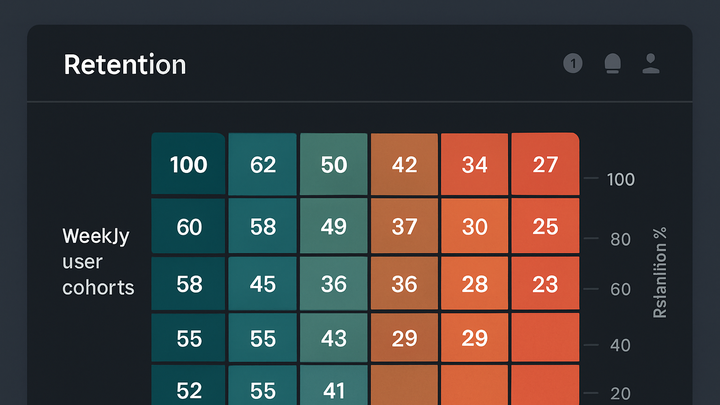Published on 2025-06-22T09:21:39Z
What is a Retention Cohort? Examples in Analytics
A retention cohort is a group of users defined by the time they first performed a key action (e.g., signup or purchase). By tracking these cohorts over subsequent periods, analysts can measure ongoing engagement and identify when and why users churn. This method provides deeper insights compared to aggregate retention metrics by enabling comparisons across different user segments and time frames. Retention cohort analysis is essential in analytics for evaluating product stickiness, optimizing the user journey, and driving long-term growth. Tools like Google Analytics 4 offer native cohort exploration reports, while privacy-focused platforms such as PlainSignal allow cookie-free cohort tracking with minimal setup. Properly implemented, retention cohorts guide data-driven decisions to improve customer lifetime value and reduce churn.
Retention cohort
Groups users by their initial action date to track ongoing engagement and churn patterns over time.
Definition and Core Concepts
In analytics, a retention cohort groups users based on the date or event of their first meaningful interaction with a product or service. Instead of looking at aggregate retention rates, cohort analysis slices users into segments (cohorts) by time period or behavior, enabling more granular insights.
-
Cohort formation
Users are bucketed into cohorts based on a shared characteristic, typically the date of their first event, such as account creation or initial purchase.
-
Time-based cohorts
Groups users by the calendar period of their first action (e.g., week or month).
-
Behavioral cohorts
Groups users by a specific event or behavior, like completing onboarding or making a repeat purchase.
-
-
Retention metrics
Metrics that quantify how many users from a cohort return during subsequent intervals.
-
Retention rate formula
Calculated as
Returnees in period N / Cohort size× 100 to express the percentage of users retained.
-
Why Retention Cohorts Matter
Retention cohorts empower businesses to measure long-term user engagement, spot churn patterns, and evaluate the impact of product changes. Unlike single-point-in-time metrics, cohort analysis reveals how user behavior evolves, making it easier to diagnose issues and optimize the user journey.
-
Measure engagement over time
Shows how well a product retains users beyond their first session, highlighting stickiness and product-market fit.
-
Identify churn patterns
Reveals specific timeframes when users are most likely to drop off, guiding targeted interventions like email campaigns or feature improvements.
Implementing Retention Cohorts
This section outlines how to set up and analyze retention cohorts in Google Analytics 4 (GA4) and PlainSignal, a cookie-free, simple analytics solution.
-
Google analytics 4
GA4 includes a Cohort Exploration template in the Analysis Hub. To create a retention cohort report:
- Go to Explore > Cohort exploration
- Define the cohort by First open or a custom event
- Set the retention intervals (days, weeks, months)
This generates a table and chart showing user retention over time.
-
Accessing cohort reports
Navigate to the Analysis Hub and select the Cohort exploration template.
-
Customizing cohorts
Adjust the inclusion event, cohort granularity, and retention window to match your analysis goals.
-
PlainSignal (cookie-free analytics)
PlainSignal offers straightforward cohort tracking without cookies. To implement:
- Embed the tracking snippet in your site’s
<head> - Define the cohort event in the PlainSignal dashboard
- View retention tables and graphs in real time.
-
Embed tracking snippet
Add the following code to your site’s
<head>:<link rel="preconnect" href="//eu.plainsignal.com/" crossorigin /> <script defer data-do="yourwebsitedomain.com" data-id="0GQV1xmtzQQ" data-api="//eu.plainsignal.com" src="//cdn.plainsignal.com/plainsignal-min.js"></script> -
Configure cohorts
In PlainSignal’s dashboard, select the event (e.g.,
signup) and define the time intervals for retention analysis.
- Embed the tracking snippet in your site’s
Best Practices
Adhering to best practices ensures accurate and actionable retention cohort analysis. Use consistent definitions, choose appropriate time windows, and segment thoughtfully to uncover deep insights.
-
Use consistent event definitions
Ensure that the event you use to form cohorts is defined uniformly across your analytics setup to avoid data discrepancies.
-
Select meaningful intervals
Choose daily, weekly, or monthly intervals based on your product’s typical usage frequency to capture relevant retention trends.
-
Combine quantitative and qualitative insights
Pair cohort data with user feedback or session recordings to understand the ‘why’ behind retention patterns.
